Rear seat HONDA PASSPORT 2021 (in English) User Guide
[x] Cancel search | Manufacturer: HONDA, Model Year: 2021, Model line: PASSPORT, Model: HONDA PASSPORT 2021Pages: 607, PDF Size: 36.04 MB
Page 53 of 607
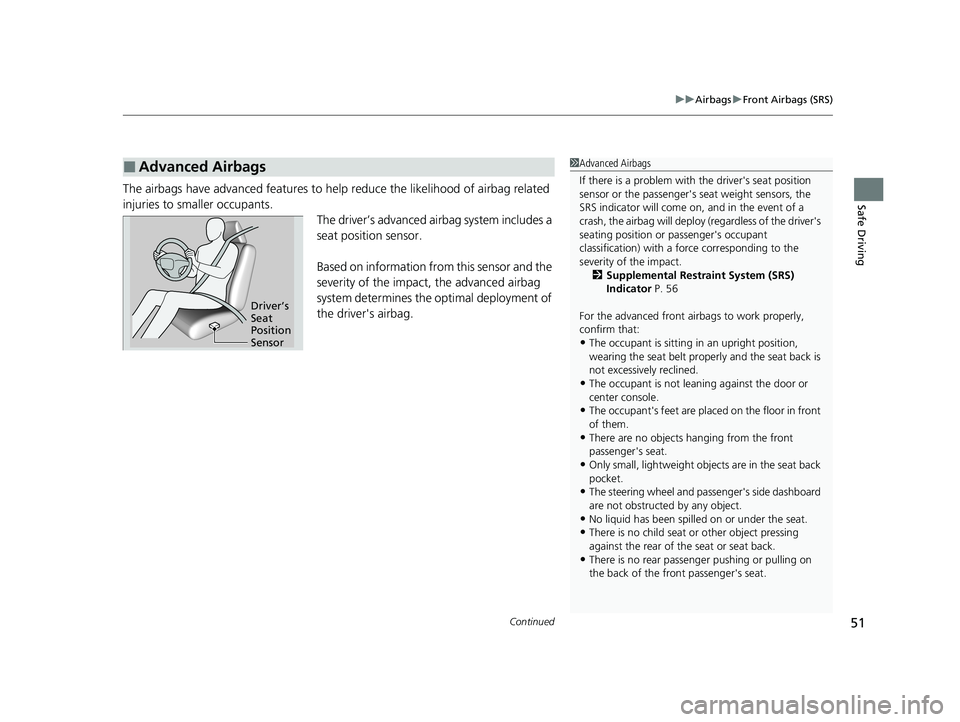
Continued51
uuAirbags uFront Airbags (SRS)
Safe DrivingThe airbags have advanced features to he lp reduce the likelihood of airbag related
injuries to smaller occupants. The driver’s advanced airbag system includes a
seat position sensor.
Based on information from this sensor and the
severity of the impact, the advanced airbag
system determines the optimal deployment of
the driver's airbag.
■Advanced Airbags1 Advanced Airbags
If there is a problem with the driver's seat position
sensor or the passenger's s eat weight sensors, the
SRS indicator will come on, and in the event of a
crash, the airbag will deploy (regardless of the driver's
seating position or passenger's occupant
classification) with a fo rce corresponding to the
severity of the impact. 2 Supplemental Restraint System (SRS)
Indicator P. 56
For the advanced front airbags to work properly,
confirm that:
•The occupant is sitting in an upright position,
wearing the seat belt prope rly and the seat back is
not excessively reclined.
•The occupant is not leaning against the door or
center console.
•The occupant's feet are plac ed on the floor in front
of them.
•There are no objects ha nging from the front
passenger's seat.
•Only small, lightweight objec ts are in the seat back
pocket.
•The steering wheel and passenger's side dashboard
are not obstructed by any object.
•No liquid has been spille d on or under the seat.•There is no child seat or other object pressing
against the rear of the seat or seat back.
•There is no rear passenger pushing or pulling on
the back of the front passenger's seat.
Driver’s
Seat
Position
Sensor
21 PASSPORT-31TGS6200.book 51 ページ 2020年9月4日 金曜日 午後2時35分
Page 59 of 607
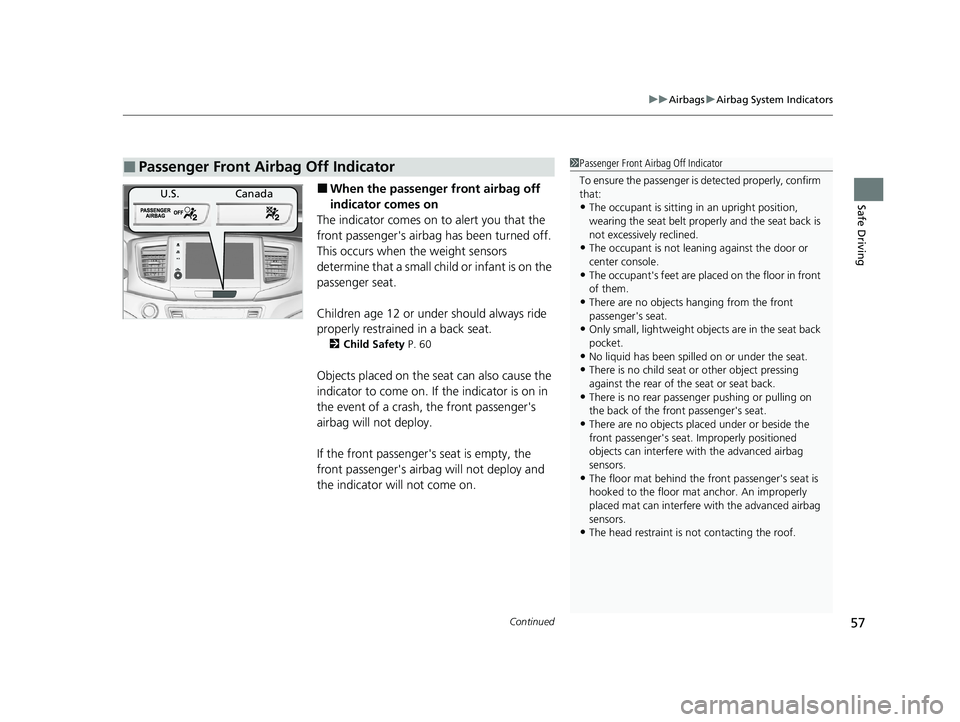
Continued57
uuAirbags uAirbag System Indicators
Safe Driving■When the passenger front airbag off
indicator comes on
The indicator comes on to alert you that the
front passenger's airbag has been turned off.
This occurs when the weight sensors
determine that a small child or infant is on the
passenger seat.
Children age 12 or under should always ride
properly restrained in a back seat.
2 Child Safety P. 60
Objects placed on the seat can also cause the
indicator to come on. If the indicator is on in
the event of a crash, the front passenger's
airbag will not deploy.
If the front passenger's seat is empty, the
front passenger's airbag will not deploy and
the indicator will not come on.
■Passenger Front Airbag Off Indicator1Passenger Front Airbag Off Indicator
To ensure the passenger is detected properly, confirm
that:
•The occupant is sitting in an upright position,
wearing the seat belt prope rly and the seat back is
not excessively reclined.
•The occupant is not leaning against the door or
center console.
•The occupant's feet are plac ed on the floor in front
of them.
•There are no objects ha nging from the front
passenger's seat.
•Only small, lightweight objec ts are in the seat back
pocket.
•No liquid has been spille d on or under the seat.
•There is no child seat or other object pressing
against the rear of the seat or seat back.
•There is no rear passenger pushing or pulling on
the back of the front passenger's seat.
•There are no objects placed under or beside the
front passenger's seat . Improperly positioned
objects can interfere with the advanced airbag
sensors.
•The floor mat behind the front passenger's seat is
hooked to the floor mat anchor. An improperly
placed mat can interfere with the advanced airbag
sensors.
•The head restraint is not contacting the roof.
U.S.Canada
21 PASSPORT-31TGS6200.book 57 ページ 2020年9月4日 金曜日 午後2時35分
Page 62 of 607
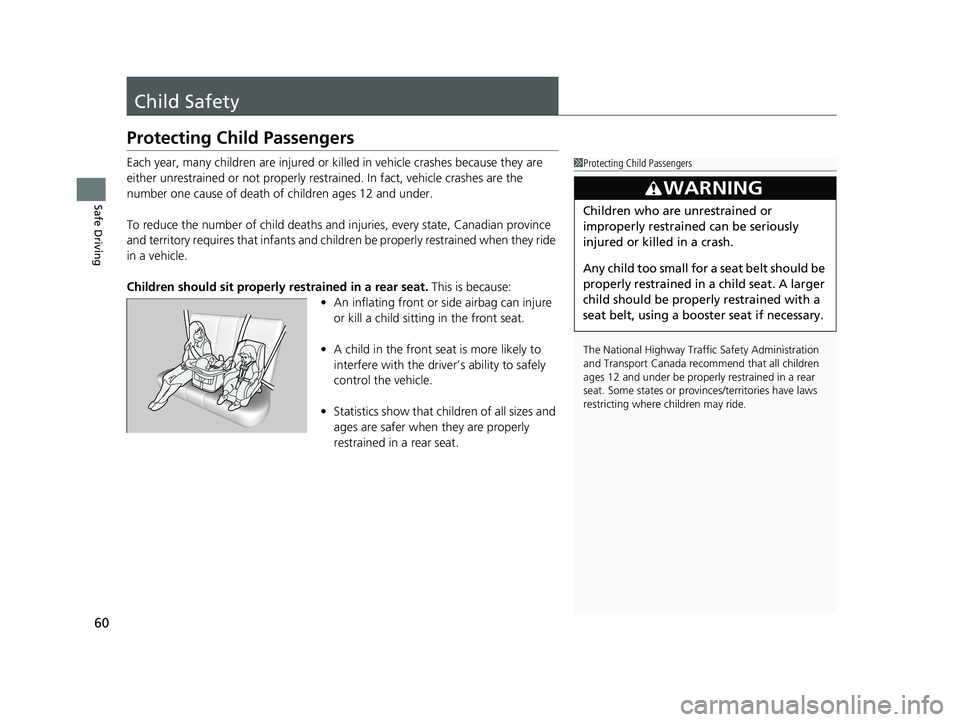
60
Safe Driving
Child Safety
Protecting Child Passengers
Each year, many children are injured or killed in vehicle crashes because they are
either unrestrained or not properly res trained. In fact, vehicle crashes are the
number one cause of death of children ages 12 and under.
To reduce the number of child deaths and in juries, every state, Canadian province
and territory requires that infants and childre n be properly restrained when they ride
in a vehicle.
Children should sit properly restrained in a rear seat. This is because:
• An inflating front or side airbag can injure
or kill a child sitti ng in the front seat.
• A child in the front seat is more likely to
interfere with the driver ’s ability to safely
control the vehicle.
• Statistics show that ch ildren of all sizes and
ages are safer when they are properly
restrained in a rear seat.1 Protecting Child Passengers
The National Highway Traffic Safety Administration
and Transport Canada reco mmend that all children
ages 12 and under be properl y restrained in a rear
seat. Some states or provin ces/territories have laws
restricting where ch ildren may ride.
3WARNING
Children who are unrestrained or
improperly restrained can be seriously
injured or killed in a crash.
Any child too small for a seat belt should be
properly restrained in a child seat. A larger
child should be properly restrained with a
seat belt, using a booster seat if necessary.
21 PASSPORT-31TGS6200.book 60 ページ 2020年9月4日 金曜日 午後2時35分
Page 64 of 607
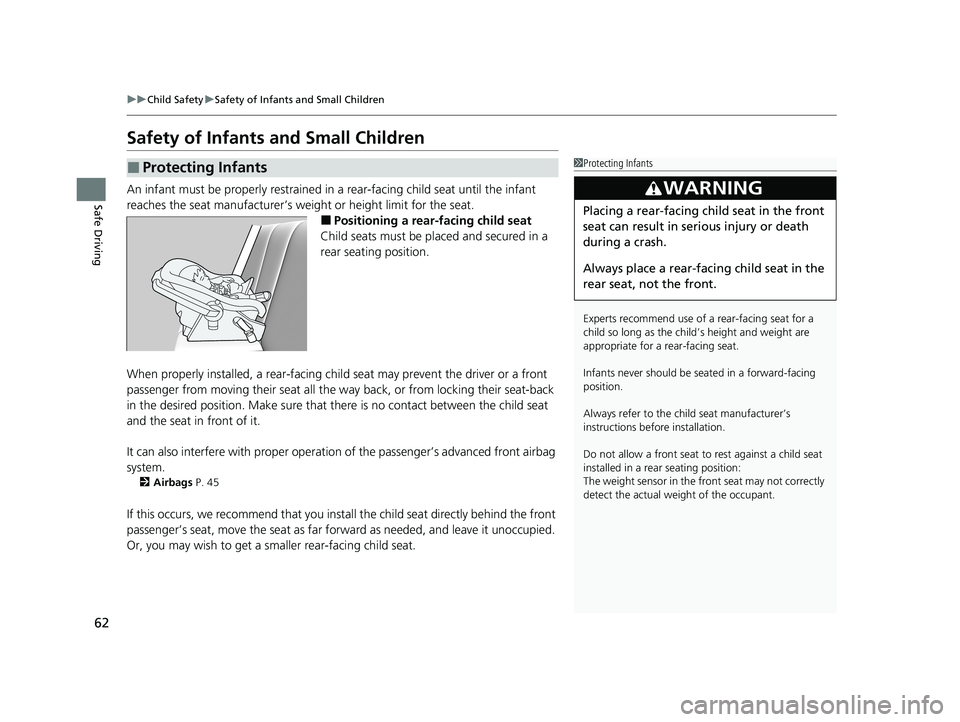
62
uuChild Safety uSafety of Infants and Small Children
Safe Driving
Safety of Infants and Small Children
An infant must be properly restrained in a rear-facing child seat until the infant
reaches the seat manufacturer’s weig ht or height limit for the seat.
■Positioning a rear-facing child seat
Child seats must be placed and secured in a
rear seating position.
When properly installed, a rear-facing child seat may prevent the driver or a front
passenger from moving their seat all the way back, or from locking their seat-back
in the desired position. Make sure that th ere is no contact between the child seat
and the seat in front of it.
It can also interfere with pr oper operation of the passenger’s advanced front airbag
system.
2 Airbags P. 45
If this occurs, we recommend that you install the child seat directly behind the front
passenger’s seat, move the seat as far fo rward as needed, and leave it unoccupied.
Or, you may wish to get a sm aller rear-facing child seat.
■Protecting Infants1Protecting Infants
Experts recommend use of a rear-facing seat for a
child so long as the child’ s height and weight are
appropriate for a rear-facing seat.
Infants never should be s eated in a forward-facing
position.
Always refer to the child seat manufacturer’s
instructions before installation.
Do not allow a front seat to rest against a child seat
installed in a rear seating position:
The weight sensor in the fr ont seat may not correctly
detect the actual weight of the occupant.
3WARNING
Placing a rear-facing child seat in the front
seat can result in serious injury or death
during a crash.
Always place a rear-fac ing child seat in the
rear seat, not the front.
21 PASSPORT-31TGS6200.book 62 ページ 2020年9月4日 金曜日 午後2時35分
Page 65 of 607
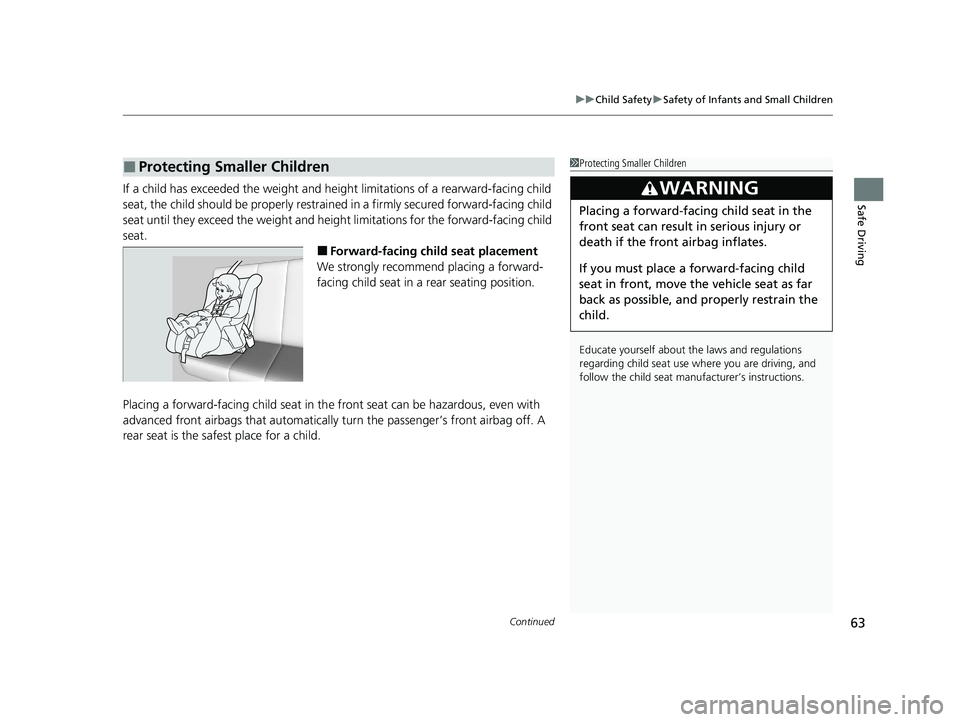
Continued63
uuChild Safety uSafety of Infants and Small Children
Safe DrivingIf a child has exceeded the weight and hei ght limitations of a rearward-facing child
seat, the child should be properly restrain ed in a firmly secured forward-facing child
seat until they exceed the we ight and height limitations for the forward-facing child
seat.
■Forward-facing child seat placement
We strongly recommend placing a forward-
facing child seat in a rear seating position.
Placing a forward-facing child seat in th e front seat can be hazardous, even with
advanced front airbags that automatically turn the passeng er’s front airbag off. A
rear seat is the safest place for a child.
■Protecting Smaller Children1 Protecting Smaller Children
Educate yourself about th e laws and regulations
regarding child seat use wh ere you are driving, and
follow the child seat manufacturer’s instructions.
3WARNING
Placing a forward-facing child seat in the
front seat can result in serious injury or
death if the front airbag inflates.
If you must place a forward-facing child
seat in front, move the vehicle seat as far
back as possible, and properly restrain the
child.
21 PASSPORT-31TGS6200.book 63 ページ 2020年9月4日 金曜日 午後2時35分
Page 67 of 607
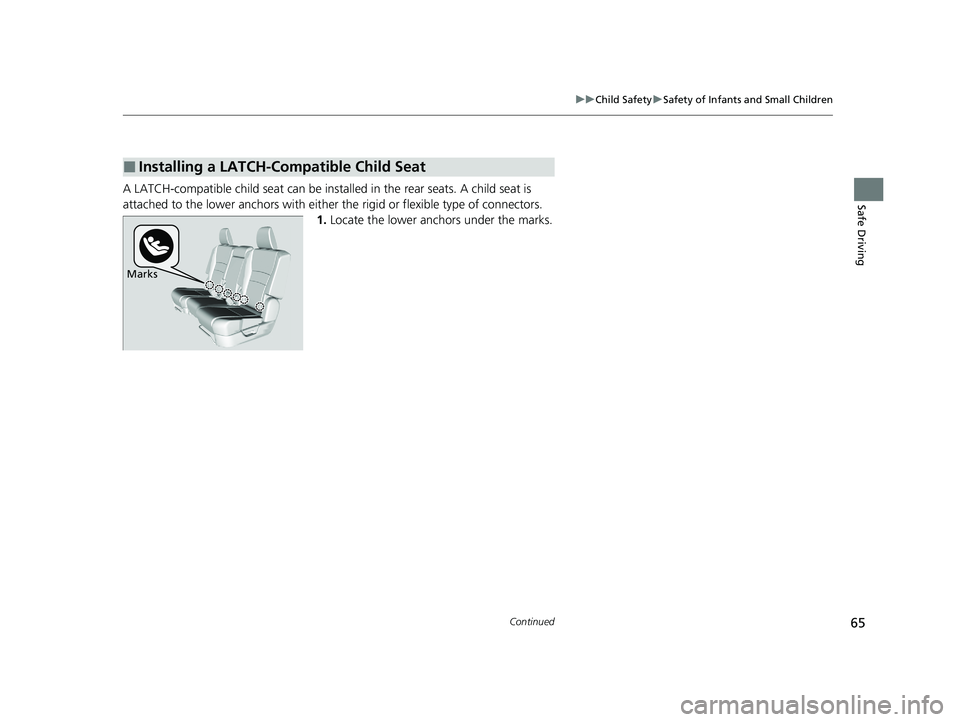
65
uuChild Safety uSafety of Infants and Small Children
Continued
Safe DrivingA LATCH-compatible child seat can be insta lled in the rear seats. A child seat is
attached to the lower anchors with either the rigid or flexible type of connectors.
1. Locate the lower anchors under the marks.
■Installing a LATCH-Compatible Child Seat
Marks
21 PASSPORT-31TGS6200.book 65 ページ 2020年9月4日 金曜日 午後2時35分
Page 70 of 607
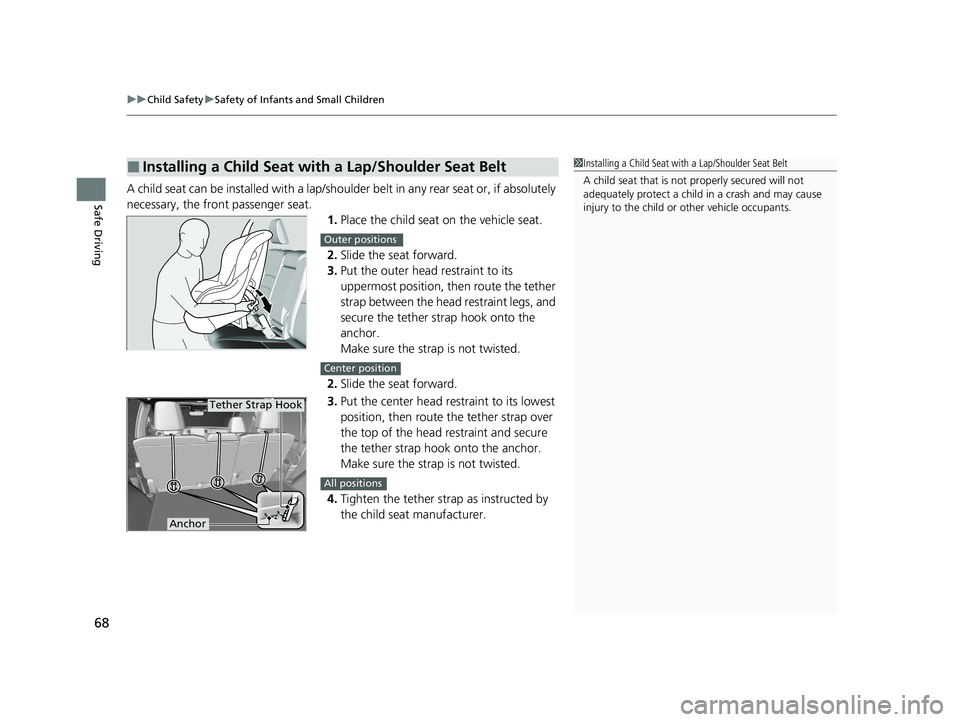
uuChild Safety uSafety of Infants and Small Children
68
Safe DrivingA child seat can be installed with a lap/should er belt in any rear seat or, if absolutely
necessary, the front passenger seat. 1.Place the child seat on the vehicle seat.
2. Slide the seat forward.
3. Put the outer head restraint to its
uppermost position, then route the tether
strap between the head restraint legs, and
secure the tether strap hook onto the
anchor.
Make sure the strap is not twisted.
2. Slide the seat forward.
3. Put the center head restraint to its lowest
position, then route the tether strap over
the top of the head restraint and secure
the tether strap hook onto the anchor.
Make sure the strap is not twisted.
4. Tighten the tether strap as instructed by
the child seat manufacturer.
■Installing a Child Seat with a Lap/Shoulder Seat Belt1Installing a Child Seat with a Lap/Shoulder Seat Belt
A child seat that is not properly secured will not
adequately protect a child in a crash and may cause
injury to the child or other vehicle occupants.
Outer positions
Center position
Tether Strap Hook
Anchor
All positions
21 PASSPORT-31TGS6200.book 68 ページ 2020年9月4日 金曜日 午後2時35分
Page 73 of 607
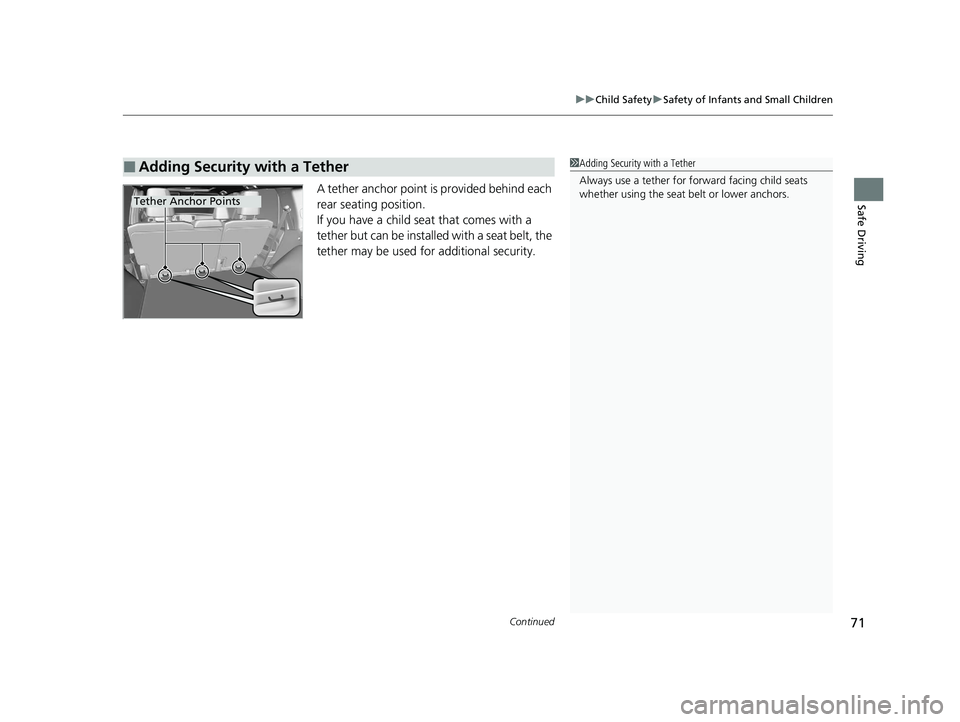
Continued71
uuChild Safety uSafety of Infants and Small Children
Safe DrivingA tether anchor point is provided behind each
rear seating position.
If you have a child s eat that comes with a
tether but can be installed with a seat belt, the
tether may be used for additional security.
■Adding Security with a Tether
Tether Anchor Points
1 Adding Security with a Tether
Always use a tether for forward facing child seats
whether using the seat belt or lower anchors.
21 PASSPORT-31TGS6200.book 71 ページ 2020年9月4日 金曜日 午後2時35分
Page 75 of 607
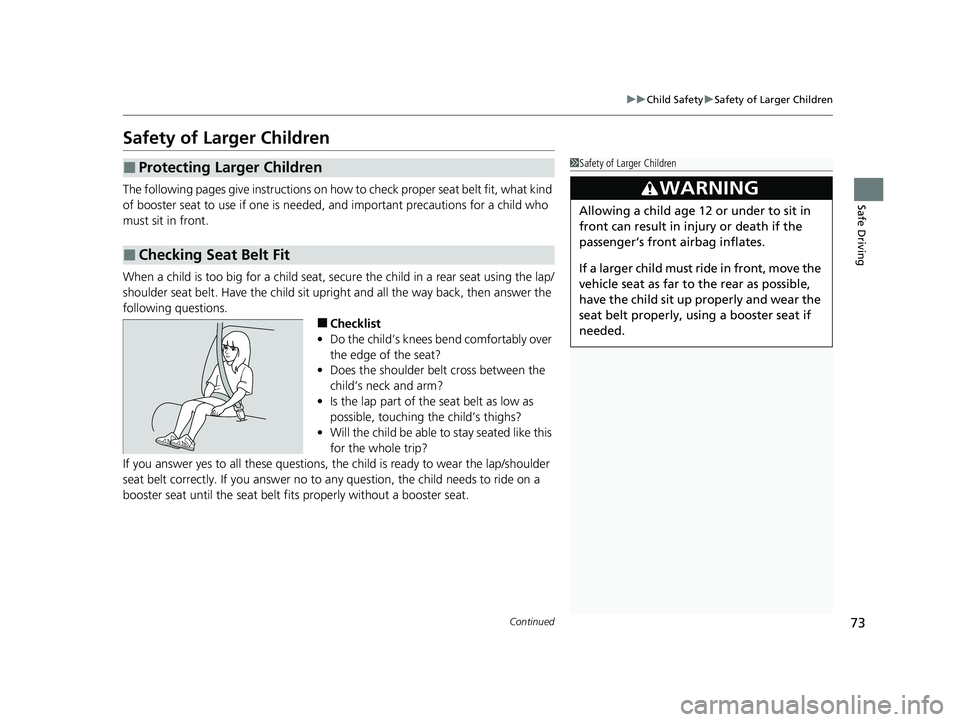
73
uuChild Safety uSafety of Larger Children
Continued
Safe Driving
Safety of Larger Children
The following pages give instructions on how to check proper seat belt fit, what kind
of booster seat to use if one is needed, and important precautions for a child who
must sit in front.
When a child is too big for a child seat, secure the child in a rear seat using the lap/
shoulder seat belt. Have the child sit upri ght and all the way back, then answer the
following questions.
■Checklist
• Do the child’s knees bend comfortably over
the edge of the seat?
• Does the shoulder belt cross between the
child’s neck and arm?
• Is the lap part of the seat belt as low as
possible, touching the child’s thighs?
• Will the child be able to stay seated like this
for the whole trip?
If you answer yes to all these questions, th e child is ready to wear the lap/shoulder
seat belt correctly. If you answer no to any question, the child needs to ride on a
booster seat until the seat belt fits properly without a booster seat.
■Protecting Larger Children
■Checking Seat Belt Fit
1 Safety of Larger Children
3WARNING
Allowing a child age 12 or under to sit in
front can result in injury or death if the
passenger’s front airbag inflates.
If a larger child must ride in front, move the
vehicle seat as far to the rear as possible,
have the child sit up properly and wear the
seat belt properly, using a booster seat if
needed.
21 PASSPORT-31TGS6200.book 73 ページ 2020年9月4日 金曜日 午後2時35分
Page 76 of 607
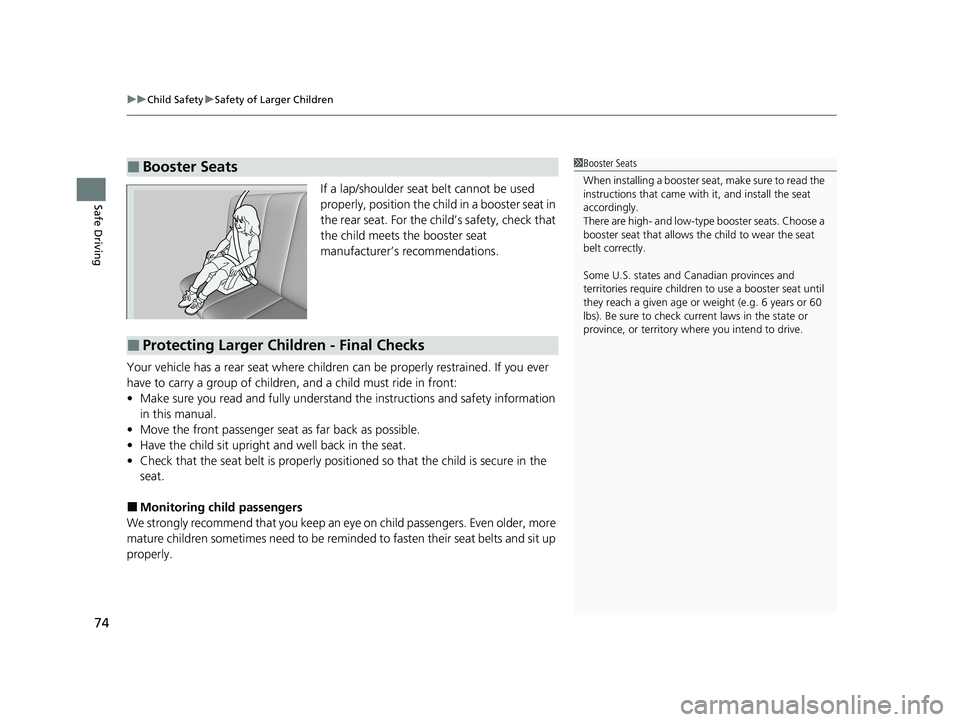
uuChild Safety uSafety of Larger Children
74
Safe DrivingIf a lap/shoulder seat belt cannot be used
properly, position the child in a booster seat in
the rear seat. For the ch ild’s safety, check that
the child meets the booster seat
manufacturer’s recommendations.
Your vehicle has a rear seat where children can be properly restrained. If you ever
have to carry a group of children, and a child must ride in front:
• Make sure you read and full y understand the instructions and safety information
in this manual.
• Move the front passenger seat as far back as possible.
• Have the child sit upright and well back in the seat.
• Check that the seat belt is properly positi oned so that the child is secure in the
seat.
■Monitoring child passengers
We strongly recommend that you keep an eye on child passengers. Even older, more
mature children sometimes need to be remind ed to fasten their seat belts and sit up
properly.
■Booster Seats1 Booster Seats
When installing a booster seat , make sure to read the
instructions that came with it, and install the seat
accordingly.
There are high- and low-type booster seats. Choose a
booster seat that allows the child to wear the seat
belt correctly.
Some U.S. states and Canadian provinces and
territories require children to use a booster seat until
they reach a given age or weight (e.g. 6 years or 60
lbs). Be sure to check current laws in the state or
province, or territory where you intend to drive.
■Protecting Larger Children - Final Checks
21 PASSPORT-31TGS6200.book 74 ページ 2020年9月4日 金曜日 午後2時35分